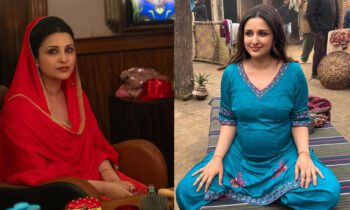This Initiative Empowers Artisans And Facilitates Employment And Education Opportunities For Women

Artisans are the backbone of the textile industry but are seldom given due credit, appreciation or recognition for their crafts. In the times when customers flock to international brands’ stores and showrooms, these talented artisans struggle to keep their dying art alive and make ends meet everyday. There are some government bodies and private institutions who are assisting and aiding these artisans with opportunities and relevant facilities to sustain in the thriving markets. Antaran is one such initiative started by Tata Trusts that is dedicated to empower, employ and educate artisans to help sustain the often neglected handloom community. It currently works with six artisan clusters across four states in India; Kamrup and Nalbari in Assam, Maniabandha and Gopalpur in Odisha, Dimapur in Nagaland and Venkatagiri in Andhra Pradesh. Founded in 2018, the initiative seeks to create sustained employment for the weavers and craftsmen and make them self-reliant.
The collections feature a range of products from clothing items like sarees, shawls and scarves to home décor items like cushion covers and each one is handcrafted, sustainable and unique in its designs. The artisans also get an opportunity to collaborate with fashion and textile designers for creating an amalgamation of traditional and contemporary art. The Antaran educational intervention is also a substantial part of the initiative that helps artisans and weavers learn about updated techniques, entrepreneurship and design to become business savvy and stand on their feet.
To get a better understanding of how Antaran works to empower artisans and creates opportunities while also keeping sustainability the focus point of the initiative, we talked to Mr Sharda Gautam, Head of Crafts, Tata Trusts. Here’s all the deets.
View this post on Instagram
Also Read: This Red Dress Has Travelled For A Decade And Features Embroideries By Female Artisans From 28 Countries, Including India.
Q. How does Antaran work to empower women artisans?
Antaran is currently involved with 500+ women weavers in Kamrup, Assam and Dimpaur, Nagaland and inspiring more women around in the clusters to practice the handloom craft as a means of livelihood and expression of creativity. The shift in using sustainable practises as a part of their daily weaving activities is where Antaran’s education program plays an instrumental role.
This coupled with education focused on learning about social media promotion and proper product photography are other important factors that pave the path for these women artisans to tell their stories effectively. Social media breaks down the process, thus making an artisan more accessible to the customer. Buyer interactions via Instagram and Facebook, use of hashtags, reach and engagement are all different and important chapters of the curriculum that help women weavers traverse a journey from being an artisan to an artisan entrepreneur. Today, many of these women entrepreneurs are successfully receiving orders from buyers all over the world.
View this post on Instagram
Q. Tell us some of the most interesting cultural insights you’ve gleaned from working with women artisans from different parts of the country?
Women artisans for long have been the backbone of any craft community. Right from weaving a textile to being a helping hand in the process with respect to spinning the yarn, dyeing or warping the yarn – all of these processes would be rather incomplete without their involvement.
Naga women are supposed to gift a shawl to their husbands on the day of their wedding as a symbol of their union. This traditional shawl making is a part of their culture which mothers impart to their young daughters on a routine basis. The same goes for women weavers of Assam, where many traditional rituals are dedicated to celebrating womanhood. Each of these ceremonies are symbolised with the use of a varied kind of gamosas – A traditional cloth or shawl made of cotton and silk used for ceremonial purposes or Mekhela chadors – a three-piece ceremonial saree or garment worn by the bride on her wedding day or for other occasions. Each of these textiles are unique in design and colour depending on the festivity.
Q: Tell us a little about how you view the sustainability movement in the country?
Sustainability means a certain calm, a balanced set of activities that help maintain a harmonious transition from one generation to another without harming the environment. Crafts are the perfectly resounding embodiment of sustainability. If we go back to origins, all the art and craft forms were practised with natural elements available in a particular geography which evolved with time in terms of design and skilfulness within the communities.
The pandemic brought things to a pause in 2020 – not only for those who always maintained this sustainable transition but also for those whose consistent efforts made the process a whole lot easier. This movement has taken over brands and organizations on a global level to support the concept, encourage more natural practises but our view of the same needs to be driven towards a more grass root level, where the people and communities who were born from it need to be able to reap the benefit of it i.e. – Craftspeople.
The entire lifestyle of leading a slow life, slow living practises, natural methods of doing a process are simply everyday chores for many in India, something that is now globally being looked up to as trends. But, at the same time these trends need a long-due attention, with a change in consumer behaviour that is more conscious and understanding of the processes. Thus, help maintain not just economical balance but also an ecological one, which consists of crafts and craftspeople as the protagonists of an organically sustainable movement.
View this post on Instagram
Q. How do you as a brand go beyond just the aesthetic and actually inculcate the values of sustainability in your products?
Antaran aims at bringing a grass root level change in the livelihoods and development of artisans, which is not just limited to creating assisted or self-made business opportunities but also inculcating changes that need to be passed on to the next generation in the form of creating self-driven, independent artisan brands – which become a mode of not just economic stability but also encourages artisans to take pride in the artform and its rich cultural heritage.
Antaran Education Program is thus, helping build a sustainable model through a curriculum that helps artisans go through a process of practised, tried and tested methods in design, business and digital marketing depending on the geography they belong to, and as to what serves their purpose best.
Practises such as use of non-toxic dyes, natural dyes in certain clusters, usage of hand spun yarn, instead of rayon based polyester yarn and many others are certain examples that have inculcated values of sustainability in the product development and craft practice – a movement that will grow in strength and reinforce the importance of handmade products in the years to come. Back to basics though may sound cliché will be the way forward in textile production and fashion.
View this post on Instagram
Their festive collection that launched late last year featured unique and sustainable designs melded with culture and heritage from different parts of India. According to Gautam, next on Antaran’s checklist is to facilitate and “benefit 3,000 individuals in the weaving community involved in pre-loom, on-loom, and post-loom processes and show the way forward for the growth of the handloom sector in India.” Initiative’s like these could really help bring the dying traditional arts back to life and help artisans stand on their feet. We’re here for it!

















